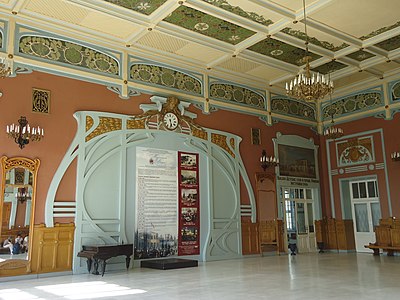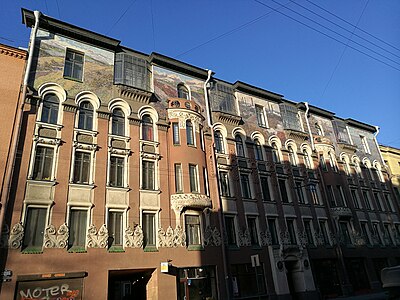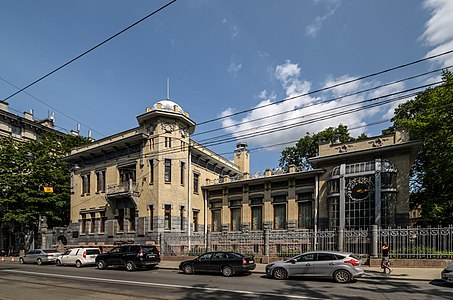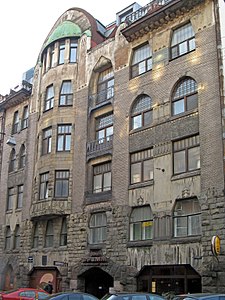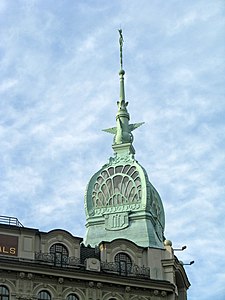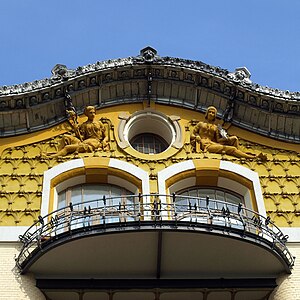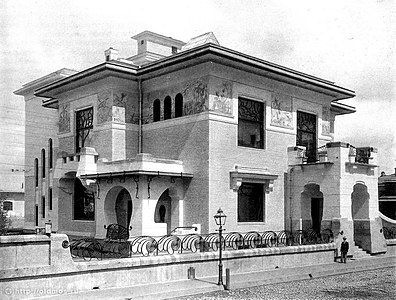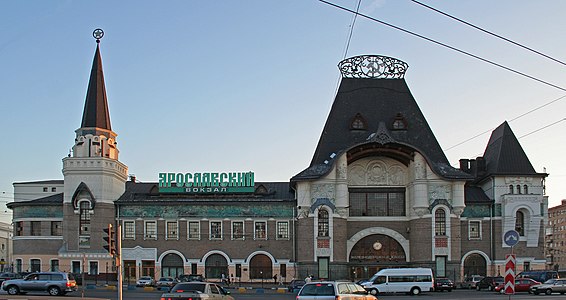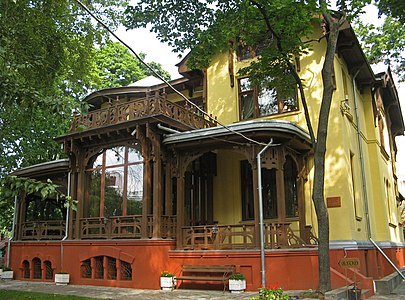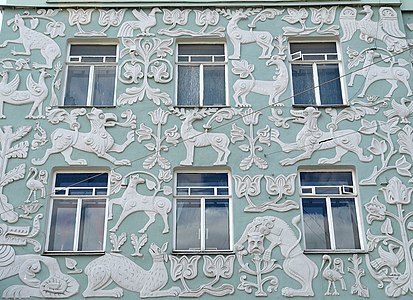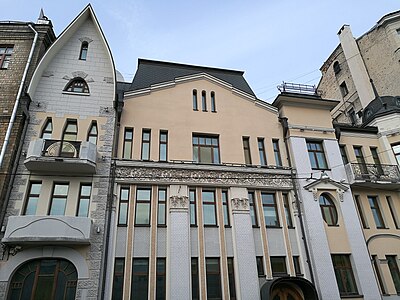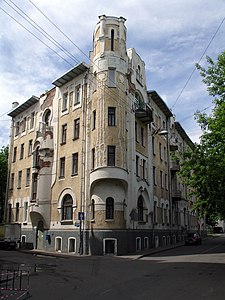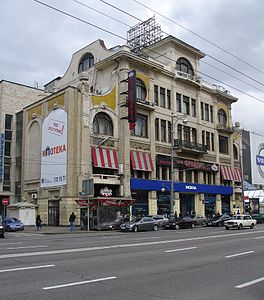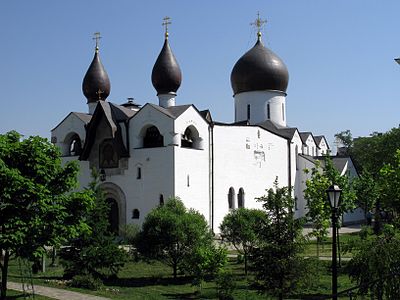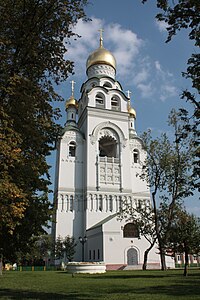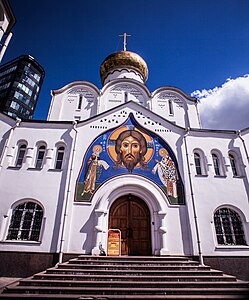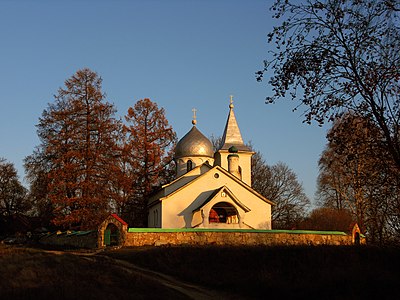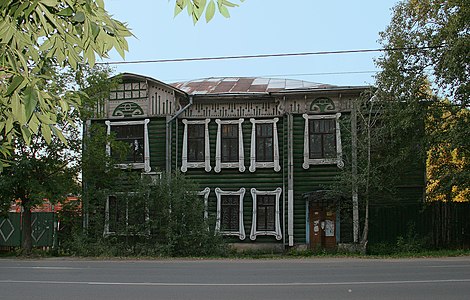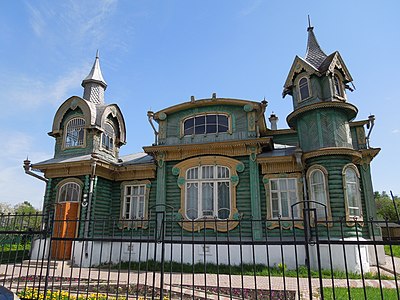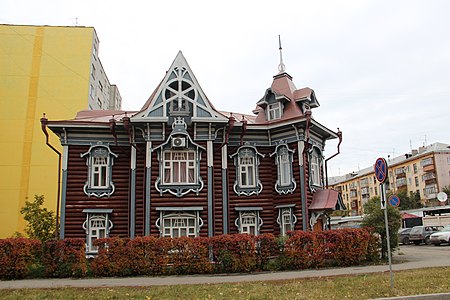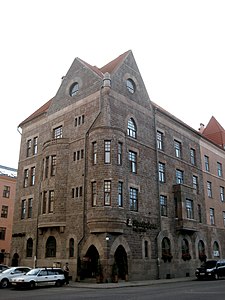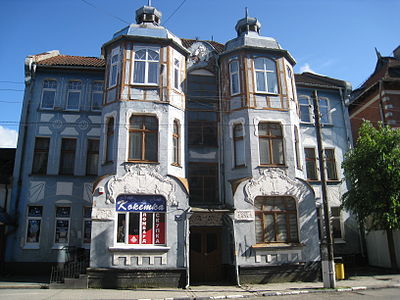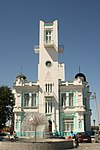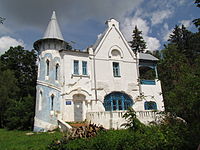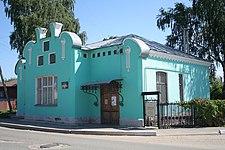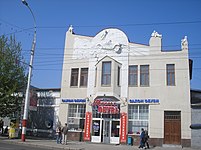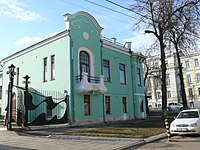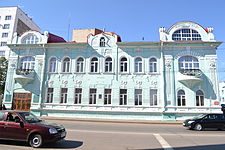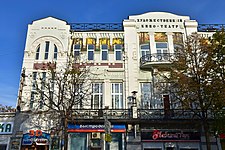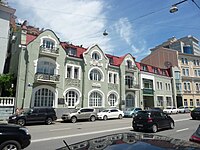User:Improver 03 04/Art Nouveau Architecture in Russia
| This is not a Wikipedia article: It is an individual user's work-in-progress page, and may be incomplete and/or unreliable. For guidance on developing this draft, see Wikipedia:So you made a userspace draft. Find sources: Google (books · news · scholar · free images · WP refs) · FENS · JSTOR · TWL |
'Art Nouveau' is an international style of art, architecture and applied art, especially the decorative arts, that was most popular between 1893 and 1910[1]. In Russian language it is called Modern (in cyrillic: Ар-нуво, Моде́рн).
Art Nouveau Architecture in Russia was mostly spread in large cities among merchants and Old Believers and was highly influenced by contemporary movements[2] that constitute Art Nouveau style: Glasgow School, Jugendstil of Germany, Vienna Secession, National Romantic style of Nordic countries (one of which, Grand Duchy of Finland, was a part of Russian Empire) and Franco-Belgian Art Nouveau movement, whose name is used for the whole style in English language. But in some Russian towns, there also were unique examples of artistic expression that mostly referred to Architecture of Kievan Rus' and Wooden architecture.
A certain part of Art Nouveau heritage in Russia also lies on territories that had belonged to Germany and Grand Duchy of Finland at the moment of creation and were ceded to Soviet Union after World War II. And vice versa, Russian architectors worked on the development of Harbin in China since 1898, that explains the presence of Art Nouveau architecture there.
Saint Petersburg
[edit]
The first Art Nouveau building in Russia was built in Saint Petersburg in 1898 [nb 1]. It was Hauswald summer house built by Vladimir Chagin and Vasily (Wilhelm) Schoene.
As Saint Petersburg was situated close to the border with Grand Duchy of Finland, there was a strong influence of its National Romantic style on Art Nouveau Architecture in Saint Petersburg. This style is called "Severny modern" in Russia (in Cyrillic: Северный модерн) meaning "Northern Art Nouveau". But European movements influenced local architecture as well.
- Masterpieces
The "Art Nouveau World" website considers 7 Saint Petersburg buildings[nb 2] as Art Nouveau masterpieces[3], all of them were built by different architectors:
- Eliseyev Emporium by Gavriil Baranovsky (1903),
- Vitebsky railway station by Sima Mihash and Stanislav Brzozowski (1904),
- Singer House by Pavel Suzor (1904),
- Duke of Leuchtenberg apartments by Fyodor von Postels (1904-1905), mostly notable for its facade-wide frieze by Sergei Schelkovy,
- Kshessinskaya House by Alexander von Hohen (1904-1906),
- Lidval apartments by Fyodor Lidval (also known as Johan Fredrik Lidvall, 1899-1904),
- Basseynaya Condominium by Ernest Wirrich, Aleksei Zazersky, Nikolai Vasilyev, Aleksei Bubyr' (1912-1917).
-
Singer House Dome
-
Duke of Leuchtenberg apartments
-
Kshessinskaya House
-
Lidval apartments
-
Basseynaya Condominium
- National Romantic style
The last two building are examples of Nordic National Romantic style. Other notable examples of that movement are:
- Roman Catholic Church of Our Lady of Lourdes by Leon Benois and Marian Peretyatkovich (1903-1909)
- Putilova Apartments (also known as House with owls) by Hyppolit Pretreaus (1906-1907),
- Bubyr' Apartments by Aleksei Bubyr and Nikolai Vasilyev (1907),
- Bolsheokhtinsky Bridge (also known as Peter the Great Bridge) by Vladimir Apyshkov (1908[4] or 1909 - 1911),
- "New Passage" Trade house by Nikolai Vasilyev (1912-1913).
- Saint Petersburg Mosque by Nikolai Vasilyev (1909-1920),
-
Church of Our Lady of Lourdes
-
Portal of Putilova Apartments
-
Bubyr' Apartments
-
"New Passage" Trade house
- Russian Revival influence
The mosque and the church at the list above are not pure National Romantic - they are influenced by Islamic and Romanesque architecture respectively. Most common examples of Art Nouveau buildings influenced by other styles are Orthodox churches with Russian Revival influence:
- Old Believers Church of Our Lady of the Sign by Dmitry Kryzanowski (1906-1907),
- Church of Peter the Metropolitan by Andrey Aplaksin (1907)
A notable secular example of a building influenced by another style is Esders and Scheefhaals building by Vladimir Lipsky (1907)
-
Church of Our Lady of the Sign
-
Church of Peter the Metropolitan
-
Spire of Esders and Scheefhaals building
Moscow
[edit]- Lev Kekushev
The first Art Nouveau building in Moscow was built in 1898-1899 - it is List House by Lev Kekushev[5]. Kekushev was acquaintant with Victor Horta[1], the initiator of Art Nouveau, and was his follower. Kekushev's buildings are notable for his skillful use of metal ornaments and his signature with a lion (Lev) ornament or sculpture.[6]
Most prominent buildings of Lev Kekushev built in Art Nouveau style[7] include:
- Kekushev House (also known as Kekusheva House, as he had to cede it to his ex-wife in settling their divorce), 1900-1903,
- Mindovsky House (1903)
- Isakov Apartments (1904-1906)
Lev Kekushev also took part in the construction of Hotel Metropol. In 1898-1899, he won the first prize in the open contest, but the commissioner of the project Savva Morozov discarded the decision of a professional jury and awarded the prize to William Walcot. However, the owners retained Kekushev as overall project manager. As William Craft Brumfield wrote in his book "The Origins of Modernism in Russian Architecture", "Kekushev's assistance was probably crucial to the final realization of this complex structure, with its immense dome of glass and iron over an interior court"[8].
-
List House
-
A lion's statue on top of Kekushev House
-
Mindovsky House
-
Decor of Isakov Apartments
-
Maiolica panel of Mikhail Vrubel and bas-reliefs at the facade of Hotel Metropol
- Franz (Fyodor) Schechtel
Another influential master of Russian Art Nouveau who worked in Moscow was Franz (Fyodor) Schechtel. Starting his career with Neo-Gothic buildings and finishing career with Neoclassical ones, he built his best-known masterpieces in Art Nouveau style. In 1901 he was commissioned to build the pavilion of Russia at Glasgow Exhibition. There he gained international recognition and got to know Charles Rennie Mackintosh who influenced Schechtel's art. Another influencer is Joseph Maria Olbrich, the founder of the Darmstadt Artists' Colony, whose Ludwig Habich House was an inspiration for Ryabushinsky House(1900-1903)[9]. Along with that building his masterpieces in Moscow include[7]:
- Derozhinskaya House (1901),
- Yaroslavsky railway station (1902-1904). Its style is also described as Neo-Russian. It is the technique of combining Art Nouveau principles with Old Russian architecture that sets Yaroslavsky station apart from other Art Nouveau buildings in Russia (being mostly influenced by the art of foreign architectors[2]).
-
Ryabushinsky House
-
Derozhinskaya House
- Other outstanding examples
Another outstanding example of Neo-Russian/Art Nouveau building in Moscow is Pertsova House (also known as Pertsov House), built 1905-1907 after a project of Sergey Malyutin, an artist of Mir iskusstva movement. Though Lev Kekushev's Nosov House was influenced by Franco-Belgian Art Nouveau[10] and American cottages[11], being built of wood it is still a unique example. By some researches[2] Trinity Church Apartments (also known as House with Beasts) are also characterized as Art Nouveau. This building is mostly notable for stone carving made by Sergei Vashkov inspired by carvings of Cathedral of Saint Demetrius in Vladimir and Saint George Cathedral in Yuryev-Polsky of XII and XIII centuries.
-
Pertsova House
-
Nosov House
-
Bas-reliefs at facade of Trinity Church Apartments
- National Romantic style
The influence of Nordic National Romantic style was weaker in Moscow than in Saint Petersburg. Buildings with influence that style in Moscow are:
- Lomakina Apartments and Tsirkunov Heirs Apartments by Vitaly Maslennikov,
- Kalinovskaya Apartments by Ernst Richard Nirnsee with ceramics of Alexander Golovin,
- Loskov Apartments by Alexander Zelenko.
-
Lomakina Apartments
-
Tsirkunov Heirs Apartments
-
Kalinovskaya Apartments
-
Loskov Apartments
- Other architects
Other notable architects of Art Nouveau in Moscow include:
- Illarion Ivanov-Schitz, who developed a unique personal style, blending the Vienna Secession school with Greek Revival features,
- Georgy Makayev, who is mostly known for Tarkhova Apartments that later was bought back by the architect,
- Adolf Erichson with several buildings, most notable of them[7] is Sytin Publishers building,
- Alexey Shchusev, who is mostly known for his works during USSR time but was an architect of the katholikon of Marfo-Mariinsky Convent (also known as Martha and Mary Convent). The commissioner of the complex, Grand Duchess Elizabeth Feodorovna was born near Darmstadt that was the center of Jugendstil at the time,
- Ilya Bondarenko, who was the architect of 2 Old Believers churches.
-
Tarkhova Apartments by Georgy Makayev
-
Sytin Publishers building
-
The katholikon of Marfo-Mariinsky Convent
-
Old Believers church in Maly Gavrikov lane
-
Old Believers church in Tokmakov lane
- Old Believers churches
After the restriction to build Old Believers churches was canceled in 1905, construction of a numerous amount of Old Believers churches was started. Along with 2 churches listed above, some of them shared Art Nouveau characteristics:
- Holy Virgin Protection Church by Vladimir Adamovich and Vladimir Mayat (1907-1911)
- Belfry Church of Resurrection by Fyodor Gornostaev (1910),
- Saint Nicholas Church by Anton Gurzhienko (1914-1921),
An Old Believers chapel on the upper floor of Ryabushinsky House was also built.
-
Holy Virgin Protection Church
-
Belfry Church of Resurrection
-
Saint Nicholas Church
-
Interior of the chapel in Ryabushinsky House
Art Nouveau and Russian Revival style
[edit]- Art colonies
Art Nouveau in Russia was promoted not only by single architects but also by art colonies who worked in Russian Revival style that is sometimes considered as Russian option of National Romantic European movement. The 2 best-known colonies were situated in Abramtsevo, funded by Savva Mamontov, and Talashkino, funded by Princess Maria Tenisheva. They mostly dealt with interior and ceramics but also left architecture monuments:
- The Church of the Holy Spirit in Talashkino by Sergey Malyutin with mosaics of Nicholas Roerich (1903-1905),
- Teremok House in Talashkino by Sergey Malyutin (1901-1902) who later developed a project of Pertsova House in Moscow (see above).
Some researches include Church of the Holy Mandylion in Abramtsevo in the list of Art Nouveau buildings[12] but it was built in 1881-1891 - before the inception of Art Nouveau movement.
-
The Church of the Holy Spirit in Talashkino
-
Teremok House in Talashkino
- Churches
Most Art Nouveau churches in Russia are also considered Russian Revival. Along with already described examples some notable ones include:
- Church of the Holy Trinity in Balakovo, Saratov Oblast by Fyodor Schechtel (1908-09),
- Church of the Holy Trinity in Bekhovo, Tula Oblast by famous artist Vasily Polenov who acted as the architect for the church in his own estate (1904-1906),
- Seraphimo-Znamenskiy Skit in Bityagovo, Moscow Oblast by Leonid Stezhensky (1912),
- Resurrection cathedral in Tver by Nikolay Omelyusty (1912-1913),
- Church of the Holy Mandylion in Klyazma, Pushkino, Moscow Oblast by Sergei Vashkov and Vasily Motylyov (1913-1916).
-
Bekhovo
-
Bityagovo
-
Klyazma
- Wooden art
Wood carving is also a distinctive feature of Russian Revival style and has become a feature of Russian Art Nouveau wooden houses. Houses with wood carvings can be found not only in Central Russia but also in Siberia, namely in Tomsk.
National Romantic and Jugendstil buildings at obtained territories
[edit]The territories of Karelian Isthmus and partly East Prussia that belonged to Finland and Germany respectively were ceded to Soviet Union after World War II. The Art Nouveau heritage at Karelian Isthmus consisted of:
- secular buildings of Vyborg and Sortavala, one of which was built by famous Finnish architects Herman Gesellius, Armas Lindgren and Eliel Saarinen in 1905,
- 3 Lutheran churches by Josef Stenbäck in Primorsk, Melnikovo and Zelenogorsk (that has been included into Saint Petersburg city limits).
In East Prussia (that became Kaliningrad Oblast) houses in Zelenogradsk can be noted.
-
House in Vyborg
-
bank in Sortavala
-
ex-Lutheran church in Primorsk
-
House in Zelenogradsk
Gallery of regional examples
[edit]Notes
[edit]- ^ Some researchers (e.g. Boris Kirikov) note that the first Art Nouveau building in Russia was the estate of Grand Duke Boris Vladimirovich in Tsarskoye Selo that was built in 1896-1897. Kirikov, Boris (2014). Architecture of Art Nouveau in Saint Petersburg. Estates and Tenement Houses (in Russian). Saint Petersburg: Kolo. pp. 15–27. ISBN 978-5-4462-0044-3.
- ^ One masterpiece is interior of Grand Hotel Europe rather than a building itself
References
[edit]- ^ a b [1] Art Nouveau - Wikipedia
- ^ a b c [2] Lecture on Art Nouveau of Alexander Ivanov (in Russian)
- ^ [3] List of Art Nouveau objects in Saint Petersburg - Art Nouveau World
- ^ [4] Bolsheokhtinsky Bridge - Art Nouveau World
- ^ [5] List’s mansion - Discover Moscow
- ^ [6] Lev Kekushev - Wikipedia
- ^ a b c [7]List of Art Nouveau objects in Moscow - Art Nouveau World
- ^ William Craft Brumfield, "The Origins of Modernism in Russian Architecture", University of California Press, 1991 contents chapter 3
- ^ [8] Lecture of Ilya Pechenkin on Art Nouveau style and method (in Russian)
- ^ [9] Nosov mansion - Discover Moscow
- ^ [10] Nosov House - Russian Wikipedia
- ^ [11] Church of the Holy Mandylion - Art Nouveau World



